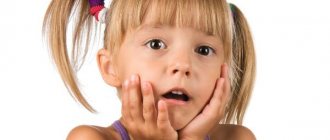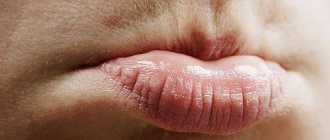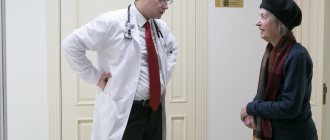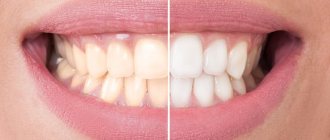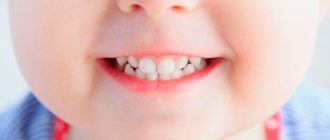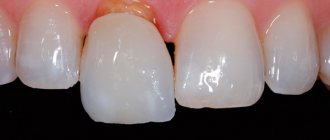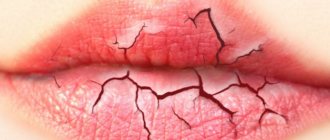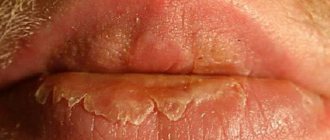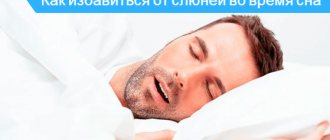Resentment and rolling tears on a child's face can be easily noticed by the shaking lower lip: this symptom indicates that the baby is about to burst into sobs. The symptom is especially noticeable in newborn babies. Strong emotions can also be a factor in why an adult's lip is shaking when trying to hide their excitement and frustration. But the women’s website “Beautiful and Successful” found out that such a symptom often indicates some kind of pathology that requires serious treatment. Read about when to worry and how to deal with the disease on this page.
Most common reasons
Why does my upper lip twitch? The most common reasons:
- Most often this is a manifestation of nervousness. Facial tics occur due to disturbances in the conduction of nerve impulses. Often patients have a question: “Why does the upper lip twitch in the middle and what to do in such a situation?” First of all, you should consult a neurologist. He will make an accurate diagnosis and prescribe sedatives.
- Mineral deficiency, particularly magnesium. In this case, muscle cramps in the legs and arms may also occur.
- The recovery period after surgery, after heavy blood loss. In order for the body to recover faster, you should maintain bed rest, avoid stress, and also take a good quality vitamin and mineral complex. It is also important to replenish magnesium deficiency in the body; Magne B6 is ideal for this.
- Why does the upper lip twitch after traumatic brain injury? Yes, impacts and brain injuries are another common cause of discomfort. As a rule, the reason lies in poor circulation. You should contact a neurologist - he will prescribe suitable medications, the use of which will help to quickly get rid of the problem.
You may be interested in: Herpes in a child’s mouth: how to treat, symptoms with photos
You may be interested in: Demodicosis: reviews of treatment, symptoms, causes and medications
Causes of lower lip twitching and additional symptoms
The lower lip can twitch constantly, or only in moments of strong emotional excitement. Tremor of this part of the face occurs under the influence of physiological or pathological reasons. In the latter case, we are talking about diseases of the body that disrupt the innervation of muscle tissue in the lower lip area. Physiological factors are considered less dangerous because they disappear on their own without the use of medications.
Brain tumors
Foreign neoplasms in the structure of the brain can cause disruption of the innervation of the facial muscles, which leads to a reflex twitching of the lower lip. Similar symptoms are caused by benign and oncological tumors of various types.
In this case, the patient has the following additional symptoms:
- dizziness;
- periodic loss of consciousness;
- nausea;
- darkening of the eyes;
- decreased visual acuity;
- attacks of severe headache;
- memory impairment;
- poor coordination of movements;
- spasms of the lower extremities;
- epilepsy attacks.
As the foreign tumor increases in size, the frequency of involuntary twitching of the lower lip increases. The risk of paresis of individual segments of the facial muscles, as well as disruption of the innervation of other parts of the body, increases.
Atherosclerosis
The lower lip twitches (the causes of tremor are determined by a neurologist) in patients with focal lesions of the central nervous system. The development of cerebral atherosclerosis leads to gradual damage to its tissues. The areas of the central nervous system responsible for the synchronous functioning of the facial muscles cease to perform their functions, as they do not receive adequate blood supply.
Twitching of the lower lip, provoked by cerebral atherosclerosis, is accompanied by the following additional symptoms:
- headache;
- absentmindedness;
- asthenia;
- memory impairment, when the patient remembers all the events of past years, but is not able to remember new amounts of information;
- noise in ears;
- insomnia at night and sleepiness during the day;
- dizziness;
- sudden mood swings;
- increased tendency to depression;
- change in speech diction;
- unsteadiness of gait;
- facial asymmetry.
The main danger of cerebral atherosclerosis is that its manifestation begins with periodic twitching of the lip and ends with partial paralysis of the body and loss of cognitive functions. A person is deprived of basic skills for independently servicing household needs.
Leptospirosis
Leptospirosis is an acute bacterial disease caused by a pathogenic microorganism of the genus Leptospira. The anicteric form of this disease is manifested by inflammatory damage to internal organs, as well as the lining of the brain.
An infected person may experience involuntary twitching of the lower lip, which is accompanied by the following additional symptoms:
- high body temperature, which is kept within 38-39 degrees;
- physical weakness and fatigue;
- dizziness;
- increased liver volume;
- impaired coordination of movements;
- hypertonicity of skeletal muscles, when the patient is unable to straighten his leg at the knee, or independently turn his neck to the side;
- attacks of severe headache;
- increased irritability of the nervous system in response to bright lights or loud sounds;
- hypersensitivity of the skin;
- oliguria.
Leptospirosis is dangerous because it can cause a reflex twitching of the lower lip, which ends in partial paresis or irreversible paralysis of the facial muscles. The causative agents of this disease enter the human body through damaged areas of the skin.
Consequences of brain injuries
Previous traumatic brain injury is one of the most common causes of involuntary twitching of the lower lip. Blows to the head, falls from great heights, and car accidents cause local hemorrhages in the structure of the central nervous system. Violation of the stable functioning of certain parts of the brain leads to pathological innervation of the facial muscles in the lower lip area.
The impact of this causative factor may be accompanied by the following additional symptoms:
- periodic loss of consciousness;
- dizziness;
- nausea;
- impaired coordination of movements;
- spasms of the lower extremities;
- epileptic seizures;
- impairment of vision or hearing;
- headache;
- speech disorders;
- increased intracranial pressure.
The frequency of involuntary twitching of the lower lip depends on the severity of the previous traumatic brain injury. Taking antiepileptic, nootropic drugs, and vitamin therapy improve the functions of damaged areas of the central nervous system.
Stressful situations
The lower lip twitches (the causes of spasm of the facial muscles are increased excitement of the peripheral nerves) in men and women who live daily under conditions of chronic stress. Psycho-emotional stress leads to neurological disorders that can cause rhythmic twitching of this part of the face.
The harmful effects of stress cause the following additional signs of a painful state of the body:
- increased irritability;
- fast fatiguability;
- loss of appetite;
- insomnia;
- absent-mindedness;
- inattention;
- sudden mood swings;
- depression;
- apathy;
- tearfulness;
- sudden attacks of anger, rage;
- headache.
When the next stressful situation occurs, the pathological symptoms worsen in terms of reflex twitching of the lower lip. In this case, the person does not feel or notice that he has a facial tic.
Facial neuritis
Inflammation of the peripheral nerves responsible for the mobility of the facial muscles can lead to involuntary twitching of the lower lip. The occurrence of this causative factor is due to hypothermia of the body, prolonged exposure to drafts, infection with infectious microorganisms that damage nerve endings.
Facial neuritis
Neuritis of the facial nerve, which caused a tic of the lower lip, is characterized by the following symptoms:
- pain in the area of the right or left ear;
- active salivation;
- loss of taste;
- hearing loss;
- facial asymmetry, which increases during conversation;
- smoothing the skin in the nasolabial fold area;
- drooping of one corner of the mouth;
- an attempt to bare teeth results in the mouth being pulled towards healthy facial nerves.
In the presence of this disease, a person feels an uncontrollable twitching of the lower lip, and also experiences difficulties with facial expressions. For example, he cannot close his eyes completely, wrinkle his forehead or smile.
Why does a child's upper lip twitch?
It would seem that children have no stress and there is no reason for the development of pathologies of the nervous system. However, doctors have a different opinion: more and more babies are being born with neurological problems. Why does a child's upper lip twitch on the left side (or right)? As a rule, this indicates that there are problems with the conduction of nerve impulses on one side or another. When making a diagnosis, the fact in which exact place the face twitches usually does not play a significant role.
Why does the upper lip twitch in teenagers? If there have been no traumatic brain injuries over the past few years, if the teenager has not undergone surgery, then most likely this is a manifestation of a common nervous tic. Below are recommendations on how to improve the condition and get rid of tic.
Causes depending on gender
The lower lip twitches (the causes of spasms of the facial muscles are determined using MRI diagnostics) in men and women with chronic fatigue syndrome.
Women
Twitching of the lower lip occurs in women who suffer from endocrine diseases.
Lower lip twitches
An imbalance of hormones leads to dysfunction of the central and peripheral nervous system, and also causes reflex spasms of the facial muscles.
Men
Nervous tics in men can be triggered by previous injuries to the facial muscles, hypothermia, or psycho-emotional stress. In workers in workshops with hazardous production, functional disorders of the facial muscles are a consequence of chronic intoxication of the body.
Facial tics and nervous tension
So, we have found the most common reason why the upper lip twitches on the left or right. Facial nervous tics almost always occur due to high nervous tension. This could be a period of passing exams, a conflict situation in the family, separation from a loved one, or the death of someone close. There are a lot of situations in our world that can cause nervous tension even in the most mentally stable person. Why does the upper lip twitch and what to do in this case if it is a facial nervous tic?
The best way out in such a situation is to abstract yourself as much as possible from the traumatic situation. Try to take time off if work is stressful. Some people often decide to quit in order to maintain a healthy psycho-emotional background. If the reason is a toxic relationship, then it is better to get out of it. If the patient is plagued by constant conflicts in the family, you should think about living separately.
Which doctor should I contact?
Often, patients are so worried about a nervous tic that they search on forums for an answer to the question: “Why does the upper lip twitch in the middle, what medications to take and how to get rid of it?” The first rule is not to panic and under no circumstances self-medicate. Really powerful sedatives are available by prescription.
If the problem has become acute, you should contact a neurologist and describe the symptoms in detail. Perhaps the facial tic is accompanied by leg or arm cramps, or a frequent headache? You should definitely inform your doctor about this. The more detailed the story, the easier it will be for the doctor to draw up a clinical picture and select medications that will quickly help solve the problem.
Diagnosis methods
The presence of a facial tic is determined by a neurologist during a visual examination of the patient. To determine the reasons that caused twitching of the lower lip, instrumental and laboratory examination methods are used. The table below lists the main diagnostic methods that are used for patients with this symptom.
| Examination method | Purpose and average cost |
| MRI of the brain | Using this diagnostic method, the general condition of the central nervous system and the blood vessels that supply it are determined. MRI allows you to detect foci of inflammation and tumor growths in the structure of the brain. The price of this examination is from 2900 rubles. |
| Venous blood analysis | Laboratory testing of a patient’s venous blood is necessary to obtain data on possible infection of the body with a viral or bacterial infection, the pathogens of which disrupt the functioning of the nervous system. The average cost of this diagnostic is from 510 rubles. |
| CT scan of the brain | During a CT scan of the brain, photographs are taken of the structural areas of the patient’s central nervous system in several planes. This examination method is comparable to radiography, but is carried out on the basis of computer technology. Price for CT scan of the brain is from RUB 3,500. |
MRI of the head.
What is normal? Depending on the clinical symptoms present in a particular patient, a neurologist may prescribe other additional diagnostic methods. For example, conducting an electroencephalogram or neuropsychiatric examination.
Groups of medications used for tics
So, we found out why the upper lip twitches. What drugs are commonly used to get rid of this unpleasant problem?
Tactics and treatment regimens
The organization of the therapeutic process depends on the causative factors that caused uncontrolled twitching of the lower lip. The treatment regimen is formed by the doctor based on the results of laboratory and instrumental examination of the patient.
Nervous tic of the lower lip
Treatment of nervous tics of the lower lip involves the use of the following therapeutic methods:
- creation of an individual zone of psycho-emotional comfort;
- a course of taking medications from the pharmacological group of nootropic drugs to improve the functions of the central nervous system and peripheral nerve endings (Glycine, Piracetam, Mildronate);
- communication with a psychotherapist who will help get rid of the psychological causes of tics;
- maintaining a balance between physical, psycho-emotional stress and proper rest;
- exclusion of stressful situations.
Therapy for a nervous tic of the lower lip is a long process that lasts from 1 to 6 months. To achieve a positive result, the patient must use all of the above treatment methods.
Chronic fatigue syndrome
The lower lip twitches (the causes of facial tremor are associated with dysfunction of the central nervous system) in men and women whose bodies are depleted by chronic fatigue syndrome.
Treatment of this disease requires compliance with the following rules:
- take a course of therapeutic massage of all parts of the musculoskeletal system;
- sleep at least 6-8 hours a day;
- avoid overworking the body;
- during operation every 60 minutes. take breaks lasting 10-15 minutes;
- during the year, rest at least 2 times for 2 weeks;
- visit the pool at least once every 7 days;
- on weekends, provide the body with proper rest without doing household chores or part-time work;
- maintain a daily routine;
- eat high-quality and biologically healthy foods rich in nutrients (fish, rabbit meat, veal, cereals, fruits, dairy products).
Chronic fatigue syndrome is dangerous not only due to the occurrence of nervous tics of the lower lip, but also to a critical decrease in the immune system. The human body becomes vulnerable to most viral and bacterial infections.
Emotional disorders
Patients with emotional personality disorders experience unstable mood, increased impulsivity, imbalance, and low levels of self-control.
To treat such mental conditions, the following normothymic and antipsychotic drugs are used:
Risperidone
- lithium-based medicines;
- Lamotrigine;
- Carbamazepine;
- Asenapine;
- Clozapine;
- Risperidone;
- Sulpiride.
The disadvantage of therapy with the above drugs is the large number of side effects that these drugs cause.
The dosage regimen for antipsychotic and normotimic medications is determined individually by the doctor, depending on the psycho-emotional state of the patient. A psychiatrist must be involved in the treatment process.
Disorders of facial innervation
Disorders of facial innervation can be caused by diseases of the central nervous system or previous traumatic brain injuries.
In this case, the following treatment regimen is used:
- massage of areas of facial tissue where peripheral nerves responsible for muscle functions pass;
- injection of potent anti-inflammatory drugs (for example, if the innervation disorder is caused by inflammatory damage to the nerve endings);
- taking antibacterial drugs by patients whose central nervous system disease is caused by infectious microorganisms;
- performing a neurosurgical operation to restore normal functioning of brain centers.
Patients with impaired facial innervation caused by a brain tumor are prescribed a course of treatment with chemicals and cytostatic agents. If there are direct medical indications, the extraneous tumor is removed.
Facial nerve neurosis
Treatment for facial nerve neurosis is carried out in the day hospital of the neurological department of the hospital.
In this case, the following treatment tactics are used:
- injection of hormonal drugs with anti-inflammatory properties;
- massage of muscle tissue in the area of which the peripheral nerve passes;
- physiotherapy of the facial area and physical therapy.
For patients with vasoneural conflict of the facial nerve in the area of the cerebellopontine ganglion, neurosurgical surgery is indicated. At all stages of treatment of this neurosis, the patient is required to comply with prevention standards. The patient should not allow the body to become hypothermic, drink alcohol, and should also avoid stressful situations.
Migraine
Treatment of migraine, which has caused a tic of the lower lip, is carried out using drugs with analgesic properties.
In this case, the neurologist prescribes the following medications:
- Ibuprofen;
- Indomethacin;
- Sumatriptan;
Sumatriptan - a triptan for headaches and migraines - Paracetamol;
- Eletriptan.
In most cases, migraine is just one symptom of an existing disease of the central or peripheral nervous system. Therefore, the task of the attending physician is not only to normalize the patient’s well-being, but also to eliminate the main factors that provoked uncontrolled twitching of the lower lip and migraine attacks.
Taking antidepressants: justified or not?
The minimum duration of a course of antidepressants is three months. Many patients are forced to take this type of medication for years, as negative symptoms return after discontinuation. However, often it is antidepressants that help a person live a full life, forget about anxiety, fears, panic attacks, and facial tics.
The most popular prescription antidepressants today are:
Often a mild tranquilizer is also prescribed in parallel - for example, Atarax. This scheme helps to quickly reduce the patient’s psycho-emotional stress.
Mild sedatives
Often, to get rid of facial tics, neurologists prescribe the following sedatives:
- "Novopassit";
- "Travisil";
- "Afobazole";
- "Berocca".
The average duration of treatment is about two months. Some patients note that facial nervous tics disappear within the first week of treatment.
Herbal sedative for nervous tics
Herbal tea "Fitosedan" is a tea made from natural herbs - valerian, motherwort, hops. Normalizes sleep and has a mild calming effect. If the facial tic is not clearly expressed and only bothers you during periods of stress, then you can get by with taking Phytosedan.
The product can be purchased at any pharmacy; you do not need a prescription from a doctor. The duration of treatment is about one month. “Phytosedan” does not cause drug dependence; you can stop taking it at any time without fear that it will negatively affect your psychological or physical state.
What can you do at home?
At home, therapy for nervous tics of the lower lip is carried out using herbal remedies with a sedative effect, as well as taking sedatives.
Herbal soothing mixture
To independently get rid of uncontrolled twitching of the lower lip, which is neurological in nature, use the herbal medicine Soothing Collection No. 2.
This medicine contains the following substances of plant origin:
- roots and rhizomes of valerian - 15%;
- peppermint foliage - 15%;
- hop fruits - 20%;
- motherwort - 40%;
- licorice root - 10%.
Calming collection No. 2 has sedative as well as antispasmodic properties. This herbal medicine removes hypertonicity of the facial muscles and eliminates signs of nervous tics of the lower lip. Calming collection No. 2 is taken orally in the form of a water infusion 2 times a day. The dosage regimen is determined by the doctor. The average duration of therapy with this herbal medicine is from 2 to 4 weeks.
Calming collection No. 2 has the following contraindications for use:
- state of pregnancy and breastfeeding of a newborn baby;
- individual sensitivity of the body to the constituent components of the herbal preparation;
- The patient's age is under 12 years.
Long-term therapy with this medication may lead to a decrease in the speed of psychomotor reactions. This fact must be taken into account by patients who drive a vehicle or are involved in work with increased danger. The price of Calming Collection No. 2 in pharmacies is about 60 rubles.
Mild sedatives
To eliminate nervous tics of the lower lip, sedatives can be used that do not suppress the functions of the central nervous system and also do not cause drug dependence.
Valerian extract
The sedative phyto-drug Valerian extract is available in the form of yellow tablets in a dosage of 20 mg. This drug is taken in a standard dosage of 1 tablet. 3 times a day. In patients who have an individual tendency to hypotension, there may be a decrease in performance, a feeling of physical weakness, and lethargy.
Valerian during breastfeeding
The average duration of therapy ranges from 14 days to 1 month. Valerian extract is contraindicated in children under 12 years of age, pregnant women and breastfeeding women. The average cost of this medication is 21 rubles. for 50 tablets.
Peony evasive tincture
Peony evasive tincture is a plant-based sedative and antispasmodic drug. 1 liter of this medication contains 50 g of peony rhizomes infused in ethanol with a concentration of 40%. Peony evasive tincture is taken 40 drops 3 times a day with a therapeutic course duration of 1 month.
The drug should be shaken thoroughly before use. Peony evasive tincture is contraindicated in children under 12 years of age, patients with an allergic reaction to this plant, as well as pregnant and nursing mothers. The average cost of a herbal medicine is 35 rubles. for 1 bottle with a capacity of 25 ml.
Twitching of the lower lip that is not under a person's control is a sign of a neurological disorder. This type of facial tic is constantly present, or it disturbs the patient periodically during moments of psycho-emotional stress. The causes of involuntary lip twitching are chronic diseases of the central nervous system, consequences of traumatic brain injuries, infectious diseases of the central and peripheral nervous system, and stressful situations.
Treatment of facial tics requires eliminating the pathological factors that provoke the neurological disorder. The patient receives injection therapy with anti-inflammatory drugs, takes sedatives and antispasmodics. To consolidate the positive effect, the patient is prescribed consultations with a psychotherapist.
Prevention of facial nervous tics
Even if you managed to get rid of a nervous tic, there is a high probability that the problems will return in the next stressful situation. How to keep your nervous system calm and prevent the problem from returning?
Source
